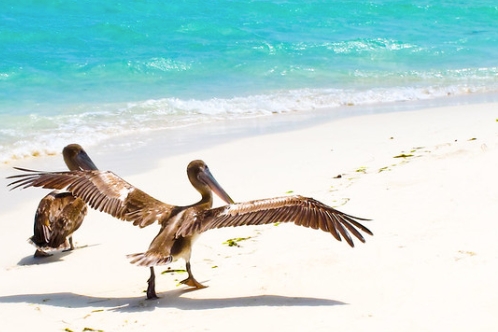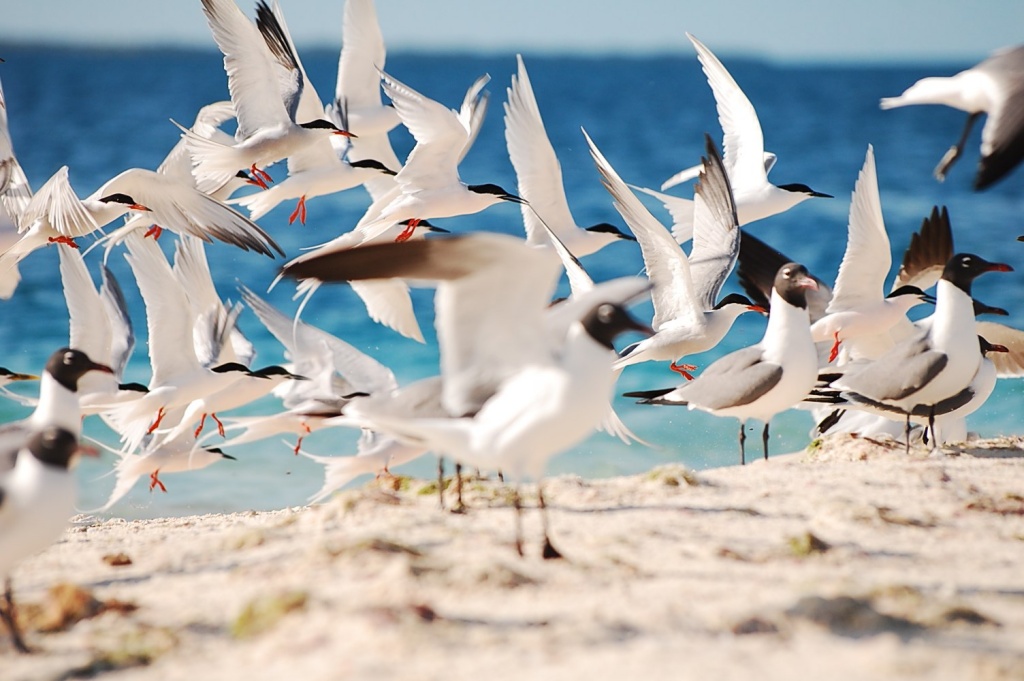Il Parco Nazionale dell'Arcipelago di Los Roques è un Parco Nazionale del Venezuela. È stata fondata nel 1972, sotto la presidenza di Rafael Caldera, avvolgente soprattutto, l'arcipelago di Los Roques, un vasto atollo corallino 36 da ovest a est e 24.6 km da nord a sud, composto da alcuni 50 isole e 282 chiavi (bagliori).
Di grande diversità e bellezza paesaggistica, si trova nel Mar dei Caraibi, appena al largo della costa del Venezuela continentale, quasi in linea retta a nord della città continentale di Caracas e La Guaira.
L'unica isola dell'arcipelago che ha una popolazione permanente è quella di Gran Roque (1.7 km²) con circa 1,200 abitanti a tempo pieno.
Perché non esiste un servizio di spedizione regolare, soltanto 15% dei visitatori arriva via acqua. Per coloro che non hanno accesso a uno yacht o una barca a vela, la migliore alternativa è volare come 85% dei turisti che arrivano Los Roques. Ci sono voli regolari da Caracas, Maracaibo e Porlamar.
Altre isole e chiavi importanti sono Francisquí, crepitio, Madrisqui, Pirata, Ferdinando, Noronquí e Dos Mosquises.

Il parco ha una delle barriere coralline più diverse e meglio conservate del Mar dei Caraibi e molte piccole spiagge appartate di sabbia bianca (distese di sabbia) sulle isole vicine / bagliori.
Ci sono una vasta gamma di attività, anche se molti visitatori vogliono solo godersi le spiagge sabbiose delle isole vicine, fare snorkeling e rilassarsi.
Un elenco completo delle attività, includere:
Kayak
Vela
Snorkeling
Pesca – “cattura e rilascia”
Immersioni in subacquea
Wind e kitesurf
Visita in barca del piccolo museo e del progetto di conservazione delle tartarughe a Dos Mosquises.
Escursionismo: il punto più alto del Gran Roque è appena 130 m sul livello del mare, ma da questo punto, il Faro, si può avere una splendida vista dell'arcipelago.
Il clima è molto fresco, con una temperatura media annua di 28 ºC e una piovosità media annua di 250 mm. Tuttavia, il sole può essere molto forte e l'uso regolare della protezione solare è essenziale.
I ristoranti sono generalmente semplici ma ci sono alcune posadas piuttosto elaborate – tutte servono favolosi frutti di mare freschi e birra fredda o cocktail. Lungo la spiaggia principale / striscia di Gran Roque troverai buone colazioni e bar "alla moda" con patii sabbiosi all'aperto. Le aragoste sono le preferite dai visitatori, anche se non servito tutto l'anno.
La ricca varietà di specie marine dell'arcipelago impressionerebbe qualsiasi subacqueo. Le barriere coralline di Los Roques sono ambienti eccezionalmente vari dove le fluttuazioni di temperatura, piccole aree di mare mosso e di calma, e aree luminose e ombreggiate dove vengono generate un'abbondanza di sostanze nutritive.
Alcune specie di pesci, come il pesce chirurgo, pesce angelo e il pesce farfalla pinna macchiata, si sono adattati soprattutto alla barriera corallina. Dovresti scegliere di immergerti a Los Roques, incontreresti una vasta gamma di pesci, pesce pappagallo, barracuda, squali nutrice, varie specie di razze e mante e schermi enormi di plancton.
Se dovessi immergerti nelle acque cristalline in un'avventura subacquea sottomarina o anche con lo snorkeling, vedresti anche un complesso ecosistema sottomarino di erbe marine. Questo ecosistema è la casa di centinaia di specie di pesci, nonché molluschi, tartarughe, lumache, la conchiglia regina e la grande stella marina.
Porta la tua famiglia in una delle migliori escursioni in barca dell'isola: lo snorkeling per le stelle marine.
Se volete una vacanza sull'isola caraibica di distanza dalle navi da crociera e villaggi turistici affollati, il Roques immersioni pacchetto vacanza Los personalizzati immersioni da Angel-Eco Tours è per voi.
Scuba pacchetti immersioni sono disponibili su richiesta. Molti viaggiatori aggiungono questo pacchetto a un altro viaggio Angel-Eco Tours. Ricorda di concedere un giorno in più per il viaggio per acclimatarsi dopo un viaggio subacqueo.
Uno dei pesci più ricercati è il Bone Fish, non crescono enormi ma per il pescatore o la donna medio o anche esperto è uno dei preferiti da catturare e in cima alla loro lista dei desideri.
Bisogna acquistare un permesso ed è bene noleggiare una barca (la maggior parte delle posada ha i propri contatti) i capitani ti porteranno poi a visitare luoghi diversi.
Sì! Per singoli o famiglie.
Los Roques, è considerato da decenni il paradiso dei pescatori. È famoso per la pesca a mosca del bonefish, uno dei pesci più veloci e belli del mare. Molti pescatori da tutto il mondo, sogno di catturare un giorno un bonefish.
Tuttavia, per la maggior parte delle persone un viaggio bonefish è troppo costoso e può essere troppo "hardcore". I pescatori hardcore pagheranno un sacco di soldi per il privilegio di alcuni giorni a caccia di questi proiettili d'argento. E può essere intenso, a volte 10 ore di pesca, sotto il caldo sole caraibico. In famiglia goditi il perfetto equilibrio di una vacanza, dove può farlo chi vuole catturare il bonefish, e chi vuole rilassarsi può rilassarsi.
Come Paolo Stanley, il Presidente di Angel-Eco, ha scritto di recente – “Durante un viaggio alcune settimane prima che la pandemia colpisse, un amico, che è un appassionato pescatore, mio fratello, un "barbone" da spiaggia e io abbiamo trascorso tre giorni / due notti in paradiso. Abbiamo visitato tre piccole isole, vicino al Gran Roque, durante i tre giorni e il mio buon amico mi ha convinto a pescare con lui in ciascuno dei luoghi in cui venivamo lasciati ogni giorno.
Durante quei pochi giorni ho pescato usando solo una semplice attrezzatura da spinning e ho pescato in giro 10-11 diverse specie di pesci, culminando in uno speciale pescato del giorno, un bonefish di buone dimensioni! Mi è stato detto che questo particolare pesce è il sogno di un pescatore. Comprensibilmente davvero dopo la lotta che ha messo su, anche meglio dei due sgombri spagnoli, dentici e barracuda che avevo catturato prima. Sono stato letteralmente catturato; Mi sono divertito molto. Dopo quell'ultima cattura ho smesso di pescare, perché sentivo di aver fatto tutto. Poi mi sono goduto il sole splendente e le splendide acque azzurre, ovviamente innaffiate da una bella birra rinfrescante (forse due!)."
Le isole sono anche un paradiso del bird-watching. Specie includono mascherato, sule dai piedi rossi e marroni, sterne fuligginose, noddies marrone, ridere gabbiani e pellicani marroni.
Della 92 specie di uccelli che sono state registrate nella arcipelago di Los Roques, 50 migrazione dal Nord America per sfuggire al rigido inverno. A causa della sua posizione, Los Roques National Sea Park è l'ideale come terreno di riposo e di alimentazione per gli uccelli.

A causa delle condizioni ambientali estreme e della mancanza di acqua dolce, gli animali terrestri non sono molto abbondanti quindi l'elenco è limitato a poche specie di iguane, lucertole, ragni, e insetti. Il pipistrello da pesca (Noctilio leporinus) è l'unico mammifero terrestre nativo.
È nell'acqua che l'immensa ricchezza diventa evidente: 307 specie di pesci, 200 specie di crostacei, 140 specie di molluschi, 61 specie di corallo e 60 specie di spugne. Ci sono anche 45 specie di ricci di mare e stelle marine. Delfini, squali, balene, mante (Manta birostris) e le tartarughe abbondano.
Gli animali maggiormente rappresentati sono la tartaruga verde (Chelonia mydas), il botuto o conchiglia regina rosa (Strombus gigas), l'aragosta (Panulirus argus), pesce tipico della barriera corallina e 92 specie di uccelli. Los Roques è un punto d'incontro per alcuni 50 specie di uccelli migratori del Nord America . Tra gli uccelli più frequenti vi è il pellicano bruno (Pelecanus occidentalis), due specie di uccelli sule, i piedi rossi (Sula sula) e la sula marrone (Sula leucogaster) e il gabbiano guanaguanare (Larus atricilla). Si possono vedere anche fenicotteri (Fenice Rossa).
Quattro tipi di tartarughe nidificano regolarmente nell'arcipelago e sono nell'elenco delle specie minacciate a livello globale: tartarughe marine (Caretta caretta), tartarughe verdi o bianche (Chelonia mydas), tartarughe liuto (Dermochelys coriacea) e tartarughe embricate. (Eretmochelys imbricata).
Geologia
La roccia originale che funge da base ha avuto origine circa 40 milioni di anni fa, nel Cretaceo superiore Sedimenti calcarei da lumache, coralli e altri detriti marini accumulati su di esso. Con il drastico innalzamento del livello dell'acqua durante l'ultima glaciazione, è stata facilitata la crescita delle scogliere che formano due barriere ben definite a nord ea sud. Questi, a sua volta, facilitato la formazione di isole e chiavi con il loro effetto protettivo.
L'origine dell'arcipelago come lo conosciamo oggi è – geologicamente parlando – molto recente, solo risalenti 10,000 a 15,000 anni. Los Roques ha la particolarità di essere l'unico atollo corallino al mondo la cui formazione non si è formata per attività vulcanica.
Storia
Si stima che la presenza umana a Los Roques risalga alla fine del primo millennio della nostra era. Secondo recenti studi archeologici, l'arcipelago era una destinazione frequente per gli indigeni del Lago Valencia e della costa centrale del Venezuela e forse per gli indiani Taino di Porto Rico, che venivano a compiere feste rituali e a collezionare botutos, pescare, cacciare le tartarughe, così come l'estratto di sale. Anche dopo, durante l'era coloniale, l'arrivo di persone attratte dalle perle, il sale e la mangrovia divennero frequenti. Contrabbandieri e pirati usavano le sue coste intricate come nascondiglio.
Nella seconda metà del XIX secolo, il governo venezuelano ha firmato un accordo con un uomo d'affari olandese per l'estrazione del guano, un'attività svolta principalmente da persone di Aruba, Bonaire e Curaçao. A loro dobbiamo i nomi curiosi di molte delle isole, che termina con la sillaba qui derivata dalla parola inglese “key” che significa “cay”.
A metà del XX secolo i pescatori venezuelani dell'Isla de Margarita iniziarono a stabilirsi definitivamente, inizialmente su otto delle isole e dalla creazione del parco nazionale, solo sul Gran Roque.
Il sole filtra attraverso le acque blu-verdi caldi. L'unico suono che si sente è il tuo respiro. Dalle profondità, un grande barracuda scivola vicino, e poi un pesce scoiattolo e un dentice. Nuoti più in profondità per osservare meglio i colori abbaglianti della bellissima ma fragile barriera corallina di Cabecera de Los Roques.
Stai intraprendendo un fantastico viaggio in uno dei luoghi più spettacolari al mondo per le immersioni subacquee e lo snorkeling. Si verifica una delle poche destinazioni eco-immersione nel mondo di oggi.
Quindi scegli la tua spiaggia privata per pescare o semplicemente goderti i raggi del sole - anche uno spuntino con una deliziosa aragosta e altri frutti di mare freschi locali.